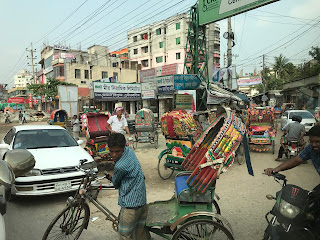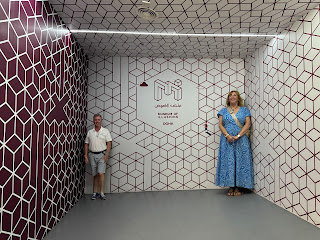Dead Cow in Calcutta, Inspirational People in Dhaka.
The day started by passing a dead cow lying on the side of the road outside of our hotel enroute to the airport. It was just lying there, rigamortise set in, legs stiff lying on its side, bazaar!
We had a white plain taxi taking us to the airport, but Calcutta is full of small yellow ambassador cabs. Mixed in with these cabs are Indian "London" red buses. They are manufactured by Ashok Leeland, I am guessing that this is an offshoot from British Leyland, but will have to research.
Today visibility was a little low so we had to request. Special VFR clearance to get going and climb to 5,000 ft on a north easterly direction. Today's flight is a short hop and we are in Bangladesh airspace with in 18 mins from departure. As we flew closer to Dhaka the scattered cloud base was at around 2,500 ft. So for a period we were above , at and then below the scattered layer. Flying Bangladesh we could see that them,and was greener and scattered with more trees and vegetation. The houses below were protected by green trees, unlike the bear surrounds we saw through central arid India. The route to Dhaka, appeared to be more of a delta like region. Indeed Dhaka, maybe on a Delta.
We were directed to carry out a circling hold over southern Dhaka, over a sports stadium, and then directed to join a left base for runway 32. Due to the smog visibility was limited, we over shot the runway, but caught sight of it in time to correct our overshoot. It was sloppy but we are on a VFR ship. We probably would have missed it altogher except for the CDI indicator provided by the VOR 32 approach selected on the GPS.
We cleared immigration, but not without garnering interest from a Bangladesh Intelligence officer. The intelligence officer took details of our passports and hotel locations etc. This was the first time we had such open interest from intelligence personnel.
At thairport terminal entrance we were picked up by a CRP (Center for the rehabilitation of the Paralysed) representative. We were picked up in one of CRP's ambulances. I jumped in the back we were shown around Dhaka enroute to the Center some 24 miles away.
Dhaka, is a big city with a population of around 20m people, Bangladesh has a population of about 160m people. Bangladesh is meant to be one of the most dense countries on the earth. We passsed the prime minister offices, home and the parliamentary buildings, our guide seemed to,want to show us the positive side if Dhaka. The streets were just dirt filled with small shops, markets stalls, of course people. The roads were chock abloc with cars, taxis, buses, coaches, bikes, bicycles, and rickshaws. As in Calcutta the Bangladesh cars drive on the left, but the roads are pandemonium, horns blaring out and people just walking through traffic. Dhaka has over 20,000 road deaths a year. The women in Bangladesh,a Muslim country, displayed fabulous colours, completely the opposite of those in Saudi Arabia. The school kids were all dressed with pressed clothes and clean white shirts. How the women and children can keep there clothes so well pressed and clean, yet they cannot managed to keep the streets clean is a mystery to me.
Enroute we passed brick foundries, clothes factories and people digging ditches along the city streets by hand. New buildings were being built with these bricks and concrete blocks were being held up by bamboo were we would use a row props. Scaffolding was erected by bamboo instead of our accustomed steel and iron. Our traditional scaffold was nowhere to be seen all was bamboo.
Eventually after about a 1.5 hour drive we turned of into a side road towards the Center. This was really a dirty road packed with shops and dwellings above the shops. No sidewalks of course so poeple were rambling along the road jostling for position amongst the rickshaws, motorbikes and a few cars. Even though the cars here really need good suspensions, they clearly do not have them I realised as my head banged the ceiling of the ambulance vehicle.
CRP focuses on a holistic approach to rehabilitation, recognizing that all aspects of the rehabilitation process are vital for its success.
Program goals
* To provide treatment, rehabilitation and support services focusing on physical, emotional, social, psychological and economic aspects. * To promote the development of skilled personnel in health care and rehabilitation in the country and the region. * To develop sub-centres in different parts of the country to expand the services for disabled people in collaboration with other organisations (NGO's, Government, self help organisations and private sector). * To organise and promote programmes for the prevention of disability. * To develop programmes for disabled children, focusing on early identification, therapeutic interventions and education.On arrival to CRP we were taken to our quarters and given a light lunch. After lunch we met up with our guide Masoud. Masoud is the public relations officer. Our first port of call was with Valerie the Centers founder and the inspiration behind it all. Valerie is a older middle aged women with a fascinating story behind her having been in Bangladesh since before its birth from East Pakistan and fighting for the freedom fighters during the nine months independence war.
The meeting with Valerie was to be brief as we were to be shown around the center before the administration office closed at 5. Firstly we were taken to Ward 1 were patients initial spend six or so weeks. Here we were confronted with the raw effects of paralysis, here the patients had various high level dergrees of paralysis. The Major causes being work related falls or due to carrying heaving loads. here the patients are given nursing care and counselling. It is also a time to teach the patients care giver, a member of the family, how to care for the patient. One of the main duties being the movement of the patient every 20 mins to prevent bed sores. This is a tough time for all.
One of the main ideas behind the centre is to allow the patients to have dignity and to send them back to there homes with some level of independence. This is achieved at various stages through occupational therapy, physiotherapy, counselling and slowing reintroducing the patient to activities that they will have to cope with outside of the centre. The final stage is where they live in similar conditions to a rural village. Here they live for sometime with there caregiver before returning home.
The centre also treats cerebral palsy. My understanding is that this occurred through Valeries's own daughter being a sufferer. For both cerebral palsy and paralysed patients the center provide wheel chairs and prosthetics were necessary.
Then center is also a teaching hospital and a school for both able bodied children as well as handicapped children.
At the end of our brief but inspiring tour we watched a wheelchair basket ball game which is an important part f the programme.
After the basket ball we were allowed to roam free and talk to both in patients and out patients.
At this point we took our chance to get out and about. we passed the gate checking out with the guards and set off up the dirt road. outside of the center many of the huts, which served as shops sold medical items and medical drugs, other shops were barbers, tailors and a wooden furniture shop. the roads were filled people, rickshaws and motorised three wheelers and cars. Chaos somehow worked, but I am sure it only works today. Everyone uses their horn, a constant noise of "beep, beep, toot toot". The locals look at us, not suspiciously but with fascination, it could be because we are westerners, but I think it is more because of our white legs reflect in the polluted sunshine.
One of the more horrific stories we heard in the center was that passengers of Chinese built three wheelers, small taxis, are being strangled, having their necks broken and killed but having scarfs hanging through a gap near the seat and getting court in the engine with the obvious consequences. This mainly effect women and girls and as been the cause of many deaths and many oatients at the centre. CRP have been actively trying to make women and children aware of the dangers as well as the taxi drivers and the Chinese manufacturers. Unfortunately the Chinese have made only a few changes but not enough to prevent the problem.
Sharmony bought us dinner at 6:30, an omelette to share between two, some rice and some vegetables, I am going to be hungry!
 |
| A right turn in Savar, near CRP |
 |
| A red bus in Calcutta |
 |
| Bangladesh form the air |
 |
| street in Savar |









Comments
Post a Comment